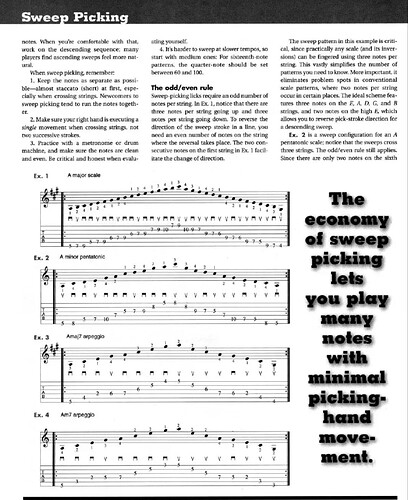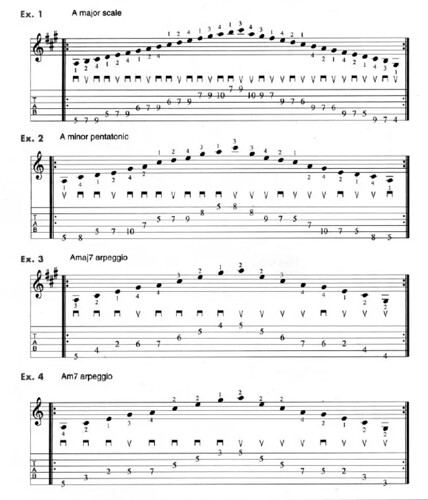after working on that hand sync for the past couple days. i have realized that has been a huge problem for me possibly. im up to 80bpm on it. i have also started counting the rhythm in my head while playing 1 e and a, 2 e and a…etc do you guys ever do that while your playing?
Hmmm I guess the speed I usually practice it at is too fast to say all the syllables, which is the point of “chunking”. Just leaning into the accents is how I keep my place. But yeah, for starting out, do what you have to do.
With economy picking, I used to find it helpful to isolate the right hand. Control over the timing of the sweeps for me was always the hardest part. Even harder when it’s the two way economy method.
I wouldn’t do it for too long, just make sure I can control the timing, then add the left hand in.
Not really. When you are working at a slow enough tempo that’s fine to count it like that, but once you start speeding it up, it becomes hard to do. Really the focus is typically on emphasizing and tracking the first down beat of each note grouping trying to be as even as you can. Even if every note isn’t perfectly even but you are still relatively in time, that’s all that really matters.
Would practicing the rest strokes by inserting a pull off or hammer on before the next string change be useful?
It might, but I think, for me at least, it was controlling the timing of the swept strokes, trying not to rush them.
I used to just practice the right hand, with muted strings, whatever lick or sequence I was working on first before adding in the left hand.
This is all just my own experience with it and what I found helpful.
My sweep timing is okay as I’m addicted to all the cliche 3 and 4 string sweep licks. I’ve just never done much Gambale style mixed sweeping and multiple notes per string economy scalar/arpeggio playing
I always throught it was solely a jazz thing but I finally watched Monster Licks & Speed Picking last night and was intrigued at the applications of this stuff in a more neoclassical context when it’s laid out in terms of chordal ideas.
This was stuff I’d heard people like Becker and Romeo do that prior to really understanding escape/pick slanting mechanics I had no hope of playing.
This is just like 
I had that dvd back in the day. I never managed to get very comfortable with the control of this sort of economy picking. I may start practicing a bit of it again to see if I can gain some sort of control over it. Can’t hurt to try anyway 
Marshall Harrison also talks about this jazz guitarist Jimmy Bruno that has an almost identical methodology of economy picking.
I have come to the conclusion that a big part of my problem currently is my fretting hand is not able to keep up at faster speeds with economy motion yet.
i mean if you are trying to move it at some crazy tempo you could be trying to fret upwards of 12 notes per second, possibly higher, with 4 fingers.  with a typing keyboard you have 8 fingers and the thumbs hitting the space bar to help with the task. it can easily wear out your left hand very fast depending on the style of phrase you are attempting.
with a typing keyboard you have 8 fingers and the thumbs hitting the space bar to help with the task. it can easily wear out your left hand very fast depending on the style of phrase you are attempting.
that explains why my fingers were sore last night. 
everybody on here can practice this and it will still make them feel the burn as long as they are playing at their redline and pushing it for faster speed. if you start to feel sharp pains though that means its time to put it away for awhile maybe until tomorrow.
The best fretting hand advice I’ve seen on the forums are these links
Similar to how if you’re using an inefficient picking motion, things feel “hard”, the same thing can happen with fretting. I have to constantly remind myself that if I feel fatigue in anything I’m doing, that means I’m probably doing it wrong. The best players have found the easiest way to do things, that’s the main reason they’re better than us. It’s rarely that they have some freaky physical capabilities.
I don’t know if this same methodology will apply to the fretting hand though, chords will take time for your hand to develop into. And when you first do them it will make your hand feel like it just went to boot camp depending on the kind of chords. Heck my hand still cannot do some of those crazy jazz chords, my ring finger just won’t banana while the thumb is trying to lip over to grab that fret on the low e string.
You are basically doing this kind of legato, but with fleet footing to go faster. So legato can be harsh, and this isn’t much different it is just a more fleet footing so at the redline you are still gonna feel that burn even though the right hand is helping to sound out the note. Now of course electric guitar gets a much better time here if they have one of those nice freboards with that wizard neck that has some extremely low action.
The only caveat and word of caution I would add to this is that new or unfamiliar motions are likely to generate fatigue in the beginning. Pay attention and recognize the difference between pain and fatigue.
When I started learning from Tom Gilroy (mentioned above) - both hands were not happy for a period of time. Even today as I start approaching larger stretches, my hand and elbows let me know when “enough” has been reached that day.
I asked him about it and he basically said “It’s new, your body isn’t accustomed. Know when to back off and rest.”
The pro players found efficient ways to play, and it looks effortless (because for them - it is). But as Yngwie said in multiple interviews - it didn’t happen all at once.
If you ever need an object lesson in how far you’ve come playing guitar…teach someone who doesn’t know how.
That is really common. The string transition is usually where you will notice it the most, and It is also the part that takes the most control. It really is no different from sweep picking 1nps arpeggios in that sense since that also tends to be the biggest issue that most people have when trying to clean those up as well.
Im sure others have different perspectives on this, but I personally think of these transitions as two separate strokes mentally, even though that may not be what is happening in reality,
In the interview Rick Beato just did with Yngwie, he (Yngwie) said something similar about the sweep not being one long stroke. I think he went so far as to say that he doesn’t sweep when he plays arpeggios, but that they are individual downstrokes. That was interesting to me because it sure looks like a sweep to me. But maybe it’s like you’re saying where he just think of it like that.
It seems he’s almost thinking of it like classical guitar rest strokes. It’s just so fast that we don’t think of the rest strokes the way Yngwie is thinking. It might explain why I’ve always thought his sweeping had a very percussive sound like he means every note its not just up and down.
Speaking of Beato interviews.
The only other person I’ve heard do those kind of percussive sweeps is Dave Mustaine on a couple songs. The intro to this being the most memorable.
That’s so funny he said that, sounds like I’m in really good company then. For me it was always about trying to get something to sound a specific way.





